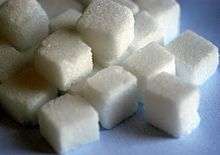Empty calories
In human nutrition, the term empty calories applies to foods and beverages composed primarily or solely of sugar, fats or oils, or alcohol-containing beverages. An example is carbonated soft drinks. These supply food energy but little or no other nutrition in the way of vitamins, minerals, protein, fiber, or essential fatty acids. Fat contributes nine calories per gram, ethanol seven calories, sugar four calories. The U.S. Department of Agriculture (USDA) advises, "A small amount of empty calories is okay, but most people eat far more than is healthy."[1] The phrase is derived from low nutrient density, which is the proportion of nutrients in a food relative to its energy content.[2]

Considering energy foods as adequate nutrition was first scientifically demonstrated to be false by François Magendie by experiments on dogs and described in his Précis élémentaire de Physiologie. He showed that eating only sugar, olive oil, or butter, each led to the death of his test animals in 30 to 40 days.[3]
Examples
The following foods are often considered[4][5][6][7] to contain mostly empty calories and may lead to weight gain:
- Sugar: cake, cookies, sweets, candy, soft drinks, fruit-flavored sweet beverages and other foods containing mostly added sugars (including High-fructose corn syrup).
- Fat: margarine, shortening and other fats and oils.
- Alcohol: beer, wine, hard spirits and other alcoholic beverages. While moderate amounts can lead to weight gain, chronic consumption of large amounts of alcohol can lead to weight loss because alcoholic liver disease is characterized by an increased metabolic rate and impaired muscle protein synthesis, resulting in sarcopenia.[8]
Impact on other nutrients
The 'empty calories' argument is that a diet high in added sugar will reduce consumption of foods that contain essential nutrients. One review reported that for increases in consumption of added sugars, nutrients at most risk for inadequacy were vitamins E, A, C, and magnesium. For these, nutrient intake was less with each 5% increase in added sugars intake.[9]
A diet high in alcohol can have the same effect. According to one review, "Micronutrient deficiencies occur in patients with ALD (alcoholic liver disease) because the major proportion of calories derived from alcohol lack minerals and vitamins. Specific emphasis is necessary for zinc, vitamin D, thiamine, folate, cyanocobalamin, and selenium." People with ALD also display sarcopenia - muscle wasting - but it is not clear if this is due to chronic low protein intake or the disease, which is known to inhibit muscle protein synthesis.[8]
Allowable intake without impacting health
Food energy intake must be balanced with activity to maintain a proper body weight. Sedentary individuals and those eating less to lose weight may suffer malnutrition if they eat food supplying empty calories but not enough nutrients.[10][11] In contrast, people who engage in heavy physical activity need more food energy as fuel, and so can have a larger amount of calorie-rich, essential nutrient-poor foods. Dietitians and other healthcare professionals prevent malnutrition by designing eating programs and recommending dietary modifications according to patient's needs.[12][13]
The USDA advises the following levels of empty calorie consumption as an upper limit for individuals who engage in 30 minutes or less of moderate exercise daily.[14]
| Gender | Age (years) | Total daily calorie needs | Daily limit for empty calories |
|---|---|---|---|
| Male | 2–3 | 1000 | 135 |
| 4–8 | 1200–1400 | 120 | |
| 9–13 | 1800 | 160 | |
| 14–18 | 2200 | 265 | |
| 19–30 | 2400 | 330 | |
| 31–50 | 2200 | 265 | |
| 51+ | 2000 | 260 | |
| Female | 2–3 | 1000 | 135 |
| 4–8 | 1200–1400 | 120 | |
| 9–13 | 1600 | 120 | |
| 14–18 | 1800 | 160 | |
| 19–30 | 2000 | 260 | |
| 31–50 | 1800 | 160 | |
| 51+ | 1600 | 120 |
See also
- Junk food
- Whole food
References
- "What are empty calories?". USDA MyPlate 2011. Archived from the original on 2014-01-30. Retrieved 2017-10-20.
- Marion Nestle and Malden Nesheim (2013) Why Calories Count: From Science to Politics, page 3, ISBN 0520952170
- Magendie, F. (1816) "Sur les propriétés nutritives des substances qui ne contiennent pas d’ azote", Annales de Chimie (ser. 2) 3:66-77, 408–410.
- "What are Empty Calories?". Choosemyplate.gov. Retrieved 2013-05-21.
- "Beware-Empty-Calories". Webmd.com. Retrieved 2013-05-21.
- "Definition Of Empty Calories". Livestrong.Com. Retrieved 2013-05-21.
- "Which foods have empty calories?". Caloriecount.about.com. 2008-04-10. Retrieved 2013-05-21.
- Dasarathy S (2016). "Nutrition and Alcoholic Liver Disease: Effects of Alcoholism on Nutrition, Effects of Nutrition on Alcoholic Liver Disease, and Nutritional Therapies for Alcoholic Liver Disease". Clin Liver Dis. 20 (3): 535–50. doi:10.1016/j.cld.2016.02.010. PMC 4934388. PMID 27373615.
- Marriott BP, Olsho L, Hadden L, Connor P (2010). "Intake of added sugars and selected nutrients in the United States, National Health and Nutrition Examination Survey (NHANES) 2003-2006". Crit Rev Food Sci Nutr. 50 (3): 228–58. doi:10.1080/10408391003626223. PMID 20301013.
- "Healthy Weight: Caloric Balance | DNPAO | CDC". Cdc.gov. 2011-10-31. Retrieved 2013-05-21.
- "A Healthier You - Chapter 6. Calories + Nutrients = Food". Health.gov. Retrieved 2013-05-21.
- "Dietitians and Nutritionists : Outlook Handbook : U.S. Bureau of Labor Statistics". Bls.gov. 2012-07-18. Retrieved 2013-05-21.
- "Vitamin and Nutrient Information from the Academy". Eatright.org. Archived from the original on 2013-05-08. Retrieved 2013-05-21.
- "Empty Calories: How Many Empty Calories Can I Have?". USDA MyPlate 2011. Archived from the original on 2014-02-01. Retrieved 2014-01-22.
External links
- "Adequate Nutrients Within Calorie Needs". Dietary Guidelines for Americans 2005. Retrieved 2006-05-09.